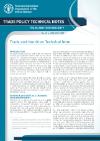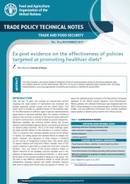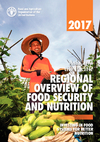Ресурсы
With the adoption of the 2030 Agenda for Sustainable Development and its ambitious goals for a more sustainable and equitable world, countries and their international partners committed themselves to regular monitoring and reporting on progress.
Ликвидация голода и нищеты, обеспечение устойчивости сельского хозяйства и продовольственных систем входят в число важнейших задач сегодняшнего дня. Этa задачa еще более усложняется в связи с продолжающимся ростом населения, фундаментальными изменениями спроса на продовольствие и угрозой массовой миграции сельской молодежи, стремящейся к лучшей жизни. В докладе представлены стратегии, направленные на усиление потенциала продовольственных...
The relationship between trade, food security and nutrition is attracting growing attention within the trade and development agendas. The Sustainable Development Goals (SDGs) cite trade as an important means to achieve the goals related to food security and nutrition. In addition, the Rome Declaration on Nutrition and the Framework for Action of the Second International Conference on Nutrition (ICN2) acknowledge that trade can play an important role in reaching nutritional targets.1 How then does international trade actually influence nutrition, and how can the positive impacts of trade on nutrition be maximized?
Over the last 10 years, the number of national-level policies targeting the triple burden of malnutrition has increased very quickly, especially outside Europe and the United States. This report aims to provide an updated picture of the evidence base on the effectiveness for different types of policies implemented by governments to promote healthier diets.
When the international community came together in 2015 to announce its ambitious 17 Sustainable Development Goals (SDGs) the mood was one of optimism. Agenda 2030, as it is now known, would, among other things, lead us to a world without hunger and poverty. Two years later, in 2017, we still believe that we can become the “zero hunger generation.” But the clock is ticking, and while good progress has been made towards eliminating hunger and poverty in the Asia-Pacific region, recent signs suggest that we must redouble our efforts in pursuit of these goals.





